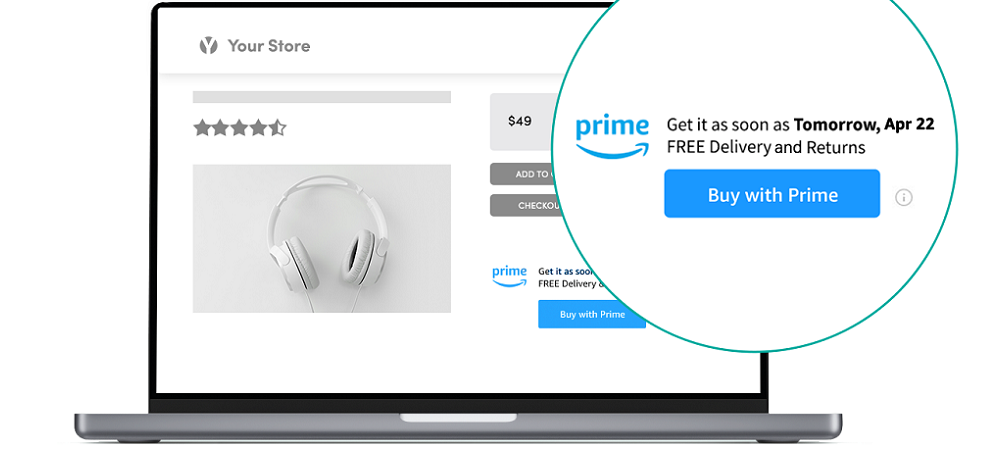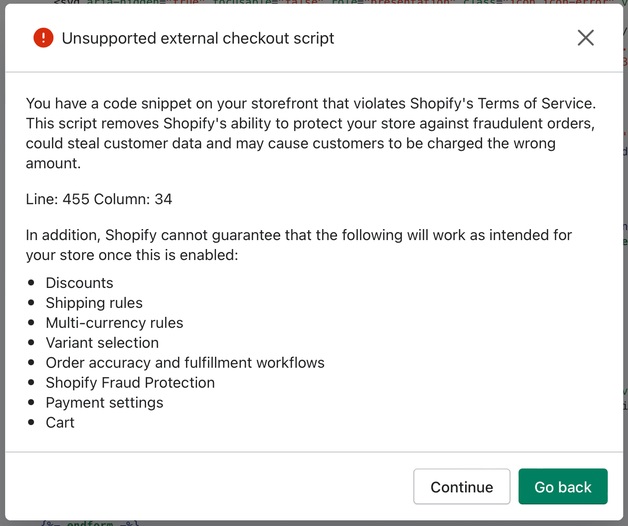
Updated January 5th 2023 with input from the Amazon Buy With Prime team.
Amazon accounts for more than 40% of online sales. There’s no longer a debate about whether to sell on Amazon or remain an exclusive DTC ecommerce seller. You need a website and presence on marketplaces.
Amazon has tricky terms of service. As a rented platform, it’s relatively inflexible, and you have less control over your business’ presence. Despite this, it’s often more convenient than running your own website. Amazon takes care of all maintenance, management, fulfillment, customer service, and other costs associated with running an ecommerce site.
The good news is since April 2022, running your website has potentially become much easier with Amazon’s Buy With Prime service. It allows you to sell on your website and have Amazon fulfill orders. Better yet, all the benefits of Fulfilled By Amazon (FBA) now apply to your website sales, like Prime shipping.

Buy With Prime brings the benefits of FBA to your website
When you insert the supplied code on your website’s product detail pages, the Buy With Prime button appears. Customers can choose to use Amazon’s checkout process, which will pull their shipping details and pass all data directly to Amazon. The display of the Prime badge signifies to customers Amazon handles packing, delivery, customer service, and returns, with the all-important free and fast shipping of Prime.
It’s almost impossible to ship as quickly and accurately as Amazon. And when 84% of consumers say they’ll avoid a brand after just one poor delivery experience, managing your own fulfillment is risky. With Buy With Prime, you can pass responsibilities like fulfilling and shipping orders and handling returns to Amazon.
In essence, you get the best of both worlds. The benefits of keeping customers on your own website can avoid the competition that comes with selling via marketplaces, provide a branded experience, and allow you to own customer data. These are in addition to using Amazon’s expert fulfillment handling at a lower cost than it would cost you to manage it. Unless you run a massive fulfillment operation, FBA can almost certainly lower your shipping and fulfillment costs, which means higher margins.
From a shopper’s standpoint, the benefits are free and fast shipping and knowing they’ll get a consistent customer experience.
Shopify now doesn’t want websites using Buy With Prime
Buy With Prime is available across most, if not all, ecommerce platforms. Some like BigCommerce and WooCommerce have easy integrations via apps. Others like Magento and Shopify need a little code copy and pasting.
As a hosted solution, Shopify has its own payment service called Shop Pay, which generates significant revenue. When a website uses Buy With Prime, customers use Amazon Pay, thus depriving Shopify of their slice of the pie. The prospect of losing payment revenue from any of their over 2.6 million US Shopify stores has displeased Shopify.
Shopify is now warning website owners that implementing Amazon’s checkout service instead of using the platform’s native service could breach their terms of service. They also state Amazon could steal data, lead to fraud, incorrectly charge customers, and cause certain features to stop working. These anti-Amazon messages are served to website owners implementing the Buy With Prime code.

This feels like scaremongering. When customers select Buy With Prime, they’re skipping the use of the features Shopify mentions, so it’s all rather moot. And claiming Amazon’s handling of data and Amazon Pay are any less secure than Shop Pay feels desperate given how many transactions Amazon runs without incident.
Interestingly, this is a 180 by Shopify, who back in May 2022 said how happy they were to integrate the feature. This could indicate more stores than they thought are adopting Buy With Prime.
Shopify website owners will have to weigh the risk of Shopify calling them out for breaking their terms of service, which states merchants “agree to use Shopify Checkout for any sales associated with your online store.” Although, it may only apply if you’re already using Shopify’s payments platform to which the Partnership Program Agreement and API terms of service apply.
Either way, Shopify is hardly likely to de-platform anyone breaking the terms of service as that would be cutting their nose off to spite their face – a non-compliance fee is a more likely solution.
Implementing Buy With Prime is Remarkably Easy
Implementing Buy With Prime is relatively straightforward. Assuming you’re already selling on Amazon, you need to link your Seller Central and Amazon Pay accounts to Buy With Prime then import your Amazon catalog information in the Buy With Prime system. It’s unclear why a separate system needs to exist rather than a simple field to flag which products are Buy With Prime. This is probably a result of Amazon’s rapid but siloed development process*. All you need to do is add the Buy With Prime button code to your website.
* January 2023 update: Amazon’s Buy With Prime team confirmed to us directly that it’s because fulfillment is performed via Amazon’s MCF service.
Just like running a FBA store, you ship inventory to Amazon to store at their fulfillment centers, which you can monitor through Seller Central or Vendor Central. When a customer orders products on your website, Amazon picks and packs the products, then ships them by the chosen method and provides the customer with the tracking information. If needed, Amazon provides customer service and return management.
Pros of Buy With Prime
Improved shipping & inventory
- A consistent ordering and shipping process across channels.
- The Prime symbol represents fast, free, and guaranteed delivery, a badge shoppers trust.
- Your products are eligible for Amazon Prime free 2-day shipping (for Prime members), and all customers can get free shipping on eligible orders.
- January 2023 update: The Buy With Prime team confirmed to us directly that there is a potential FBA storage allowance perk for users of Buy With Prime. Although they were keen to say it’s not guaranteed, this would be a welcome relief for brands which were hit by reduced storage limits in Q4 2022.
Reduced costs
- Avoids the expense of setting up your own fulfillment center or paying for a 3PL service.
- FBA 2-day shipping costs 72% less per unit than major US carriers’ 2-day shipping options and 32% less per unit than their slowest shipping options.
- The only fees you pay are storage, referral fees, and fulfillment fees (plus the $39.99/month plan membership).
Reduce hassle
- Amazon handles customer support at no extra cost–24/7 via phone or email.
- Amazon manages the returns process so you don’t have to worry about reverse logistics.
- Amazon Hub Counters provide much easier consumer returns and require no long-term contract.
Use on any platform
- Buy With Prime is available on BigCommerce, WooCommerce, Magento, and a range of other ecommerce platforms.
Data ownership
- You’ll receive customer data, including email addresses (unlike when selling on Amazon), you can use for CRM activity.
Cons of using Buy With Prime
- If you have a Shopify website and have already used ShopPay checkout and payment service, you could be breaking their terms of service.
- Keeping your DTC catalog synchronized with your Amazon catalog can take time and effort. However, synchronizing between ecommerce and Amazon just got a lot easier with third-party tools like Feedonomics and Linnworks (although that’s a whole separate topic). Then you need to remember to synchronize your Amazon catalog with your Buy With Prime catalog.
Grow your business with Buy With Prime
Handling fulfillment across different channels can be difficult and expensive. Amazon’s Buy With Prime cures that headache. It can deliver significant savings while providing customers with the tangible benefits of fast and free shipping and robust customer support.
There’s really no reason to put off implementing Buy With Prime on your ecommerce website for products it makes sense for (i.e., no oversized or expensive products). If you have a Shopify site, it may be wise to check with your legal counsel, but as previously stated, it’s unlikely Shopify will close down any websites implementing Buy With Prime. Those websites still represent significant revenue for Shopify even without 100% of the Shop Pay revenue.
If you want help navigating which products to sell on Amazon and which to sell on your website and/or help to implement Buy With Prime, talk to Emplicit’s Amazon experts today.

